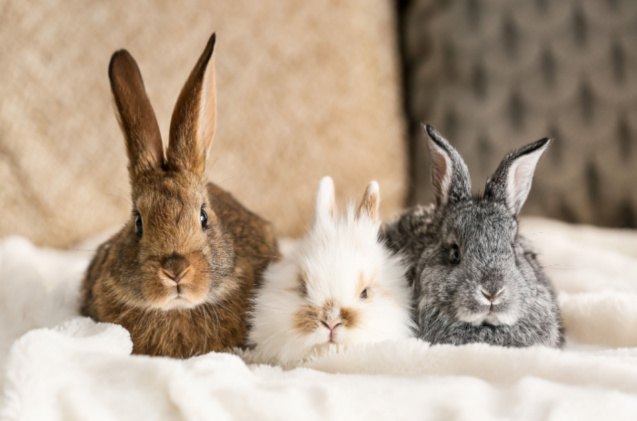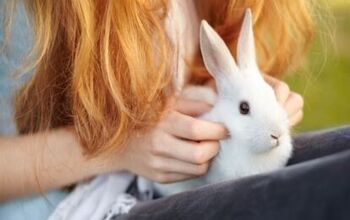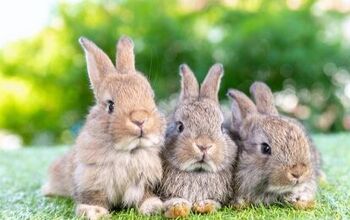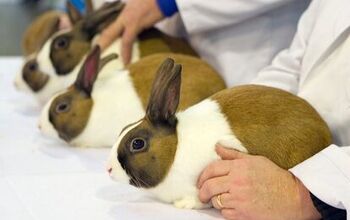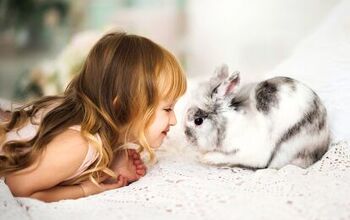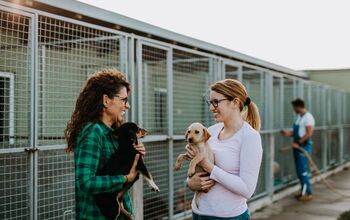10 Best Rabbits for Beginners

If you're thinking about getting a pet rabbit but you’re not sure where to start, you should first consider which breed would be the best match for your lifestyle and preferences. Some bunnies are too big to be kept in an apartment, others are a bit too high-maintenance for a first-time owner, and some have a personality that won’t click with yours. That’s why it’s important to do your research and make sure that you’ll be able to properly care for the rabbit you pick and that you’ll enjoy their quirks and unique traits as well.
To help you find the right companion for you, we’ve rounded up the 10 best rabbits for beginners, whose traits make them perfect for first-time owners. These rabbit breeds are relatively low-maintenance, tend to be friendly and sociable, intelligent and easy to train, so even a complete beginner could manage to train and socialize them with a bit of patience and effort.
#1 Mini Lop Rabbit
With their fluffy fur and small, rounded bodies, the Mini Lop looks like a bunny straight out of a children's picture book. These rabbits are not only adorable (although it is the first thing you’ll notice about them), but also have lovely personalities – generally, Mini Lop rabbits tend to be sweet, friendly, and quite affectionate. With a medium-length rollback fur, these rabbits don’t require extensive grooming and are generally considered low-maintenance and suited to newbie owners. The Mini Lop weighs 4.5 to 6 pounds on average and will be perfectly happy living in a house or an apartment, with a single or senior, or a family with children to play with.
#2 Polish Rabbit
A little bundle of cuteness, the Polish rabbit has round chubby cheeks, short ears, and round, large eyes which make them oh-so-pretty. These bunnies have a short flyback coat that’s easy to maintain and come in black, blue, chocolate, white (with red or blue eyes), and broken pattern, so any beginner can easily find a bunny to fall in love with. The Polish rabbit is docile, calm, and very affectionate, so they will make a most loving companion, especially for singles or seniors. As a dwarf breed, the Polish rabbit weighs around 2.5 to 3.5 pounds so they are not the best choice for families with young children, who could inadvertently drop or hurt such a small bunny.
#3 Lionhead Rabbit
Despite their fluffy, wooly mane, Lionhead rabbits are not a high-maintenance breed – they are a perfect compromise for beginners that are in love with fuzzy breeds with wool coats but don’t want their first rabbit to be a lot of work when it comes to grooming. Their mane could be wispy and concentrated on the head and chest (called single mane), or thick and present both on the head and on the flanks (called double mane). Lionhead rabbits are recognized by ARBA in a variety of colors and are considered well suited to first-time owners. This is, in big part, due to their friendly, playful, and affectionate temperament and small size (2.5 to 3.5 pounds in adulthood) which makes them well-adapted to life in apartments and houses alike.
#4 Harlequin Rabbit
With one-of-a-kind markings and exceptional personality, the Harlequin rabbit will quickly grow on you. Also known as the Japanese rabbit, this breed is best known for their distinctive coats that come in two variations – Magpie or Japanese. Magpie Harlequin rabbits are white with markings in black, blue, lilac, or chocolate color, and Japanese Harlequin rabbits are orange with any of the mentioned contrasting colors of markings. In addition to their striking physique, Harlequin rabbits are popular for their outgoing, sociable, curious personality which makes them interesting and loving pets to families of all shapes and sizes. They are a medium to large breed and weigh 6.5 to 9.5 pounds on average.
#5 Dutch Rabbit
These little loaves of cuteness are instantly recognizable for their rounded bodies and contrasting markings – a wedged tuft of white fur on their forehead, a band of white from the top of their shoulders to their belly, and white legs contrasted by dark fur in black, blue, speckled gray, chocolate, or orange with smokey blue shading. Dutch rabbits are a well-loved breed both because of their beautiful looks and friendly, loving personality – they thrive on affection and are considered easy to train. Perfect if you are a beginner and want a sociable, intelligent bunny you’ll quickly form a bond with. These rabbits weigh 4 to 5.5 pounds and are suited to singles, seniors, or families with children.
#6 Himalayan Rabbit
Considered to be one of the oldest breeds of rabbits in the world – so much so, that their exact origins are lost to history – the Himalayan rabbit steadily remains one of the more popular breeds even today, centuries after first being bred. And there’s plenty of reason for it, too! Starting from their appearance, Himalayan rabbits boast unusual looks – they are always white, with dark “boots”, egg-shaped mark on their nose, and colored ears and tails. Their personality also leaves little to be desired, as these are gentle, docile, and calm rabbits that adapt well to various environments, making them perfectly suited to beginners looking for their first pet rabbit. Weighing 2.5 to 5 pounds, the Himalayan is considered to be a small rabbit breed.
#7 Mini Rex Rabbit
Mini Rex’s most notable trait is their luster, velvet-like fur that, despite its luxurious feel, is quite easy to maintain. In fact, too much brushing can ruin the beautiful texture of their coats, so it’s advised to groom them only every two weeks! In addition to their stunning coats, Mini Rex rabbits also have a great personality with a friendly temperament and calm yet curious nature, so they’ll be sociable and playful but not overly energetic. An all-around great bunny for beginners, this breed is considered small and adult Mini Rex rabbits will weigh 3.5 to 4.5 pounds.
#8 Holland Lop Rabbit
If you have a soft spot for long, floppy ears, you’ll fall head over heels for the pretty Holland Lop. These rabbits were selectively bred to display large furry ears that fall to the sides of their head, disproportionately big when compared to their small rounded head and body, which only ramps up the cuteness factor. It also doesn’t hurt their cuteness that they are a dwarf breed, weighing only 2 to 4 pounds when fully mature! Their personality is as lovable as their looks, so you can expect your Holland Lop to be sweet, gentle, and quite playful – even though they are tiny, these bunnies are energetic and will love to play and hop around the house.
#9 Mini Satin Rabbit
Yup, the name is not misleading in the case of the Mini Satin rabbit – the fur of these petite bunnies is as soft as silky satin! Their sleek coat doesn’t need much grooming though, so they are a great choice for beginners who don’t want a high-maintenance coat breed for their first pet. With a small, well-rounded body, the Mini Satin can weigh anywhere between 3 to 4.5 pounds when fully mature and will adapt well to life in an apartment or families with children – as they are big enough not to be inadvertently hurt by a young kid, but not too big for them to cuddle with. And cuddle they will – if properly socialized on time, Mini Satin is a sweet, calm, bunny with an affectionate streak that makes them true “lap bunnies”.
#10 English Spot Rabbit
Rightfully dubbed the “Dalmatians of the rabbit world”, English Spot rabbits share quite a few traits with their canine look-alikes: their elegant looks, distinct markings, and a sweet, goofy personality. The English Spot is easy to recognize for their butterfly markings on the nose, colored ears, complete with a herringbone stripe down their back, circled eyes, cheek spots, and a myriad of tiny spots on their sides. Can’t miss them even if you try! While the black and white combo is the most common, English Spot rabbits come in a variety of colors, including lilac, blue, gold, and tortoise. As a medium-sized breed, an English Spot will weigh anywhere from 5 to 8 pounds in their adulthood.
5 Essential Tips for Beginner Rabbit Owners
Being a rabbit owner comes with a lot of responsibilities – like any other pet, rabbits also require your care, attention, and affection. You will need to adapt your home to be a safe and welcoming environment for your pet bunny and make sure that you meet their needs, from nutritional to emotional. This way, you can rest assured you'll have a happy, healthy bunny that thrives in your care!
- Spay or neuter your bunny
Getting your bunny spayed or neutered isn’t only important if you don’t want them to reproduce. It also eliminates the possibility of some unwanted behaviors motivated by hormones, such as aggression, territorial urine marking, or mounting. What’s more, rabbits who have been spayed or neutered have much lower risks (or none at all) of developing some serious health issues down the road, such as pyometra, uterine, mammary, and ovarian cancer in females, and testicular cancer in males. Not to mention that rabbits that have been “fixed” tend to be calmer, friendlier, and more affectionate with their owners.
- Rabbit-proof your home
Rabbits are notorious chewers and will gnaw at anything if given a chance, so you will have to move any dangerous or important items out of their reach. Cords and wires are the first to go, as they are one of the favorite forbidden “treats” of bunnies and, needless to say, can be very dangerous if chewed on, and inconvenient for you when you reach for your charger only to realize it’s been snipped in half. Baseboards should also be protected as well as wooden furniture legs, same as any plants you have – especially if they happen to be toxic to bunnies like many of them are.
- Litter train your rabbit
If you’re opting to keep your bunny indoors, as many pet owners do, you’ll want them to know where to go potty instead of doing their business all over your home. Luckily, rabbits can be successfully trained to use a litter, although they can be a bit more difficult to train than a dog or a cat, with a little patience, it’s more than possible. You’ll need to get a rabbit litter box and litter that’s appropriate for bunnies (not cat litter!) which is usually made from paper, as it is the safest for rabbits.
- Choose the right housing
Even though a rabbit should spend most of their time outside their enclosure, that doesn’t mean that they don’t need a spacious, comfy enclosure for those periods of time they are inside it. As a rule of thumb, a rabbit’s enclosure should be 4 times their size, so they can comfortably hop around, lie down, and stand up. Their enclosure should contain a sleeping area, their litter, and their food and water, as well as some toys to pass the time.
- Provide proper diet
A rabbit’s diet consists primarily of timothy hay – around 80% – which they should be given in unlimited quantities, with a limited amount of rabbit pellets, with helpings of leafy greens. It’s crucial that your bunny’s diet is high in fiber, as it supports their digestive system and helps prevent GI stasis, a dangerous life-threatening condition that is common for bunnies.

A proud mama to seven dogs and ten cats, Angela spends her days writing for her fellow pet parents and pampering her furballs, all of whom are rescues. When she's not gushing over her adorable cats or playing with her dogs, she can be found curled up with a good fantasy book.
More by Angela Vuckovic



